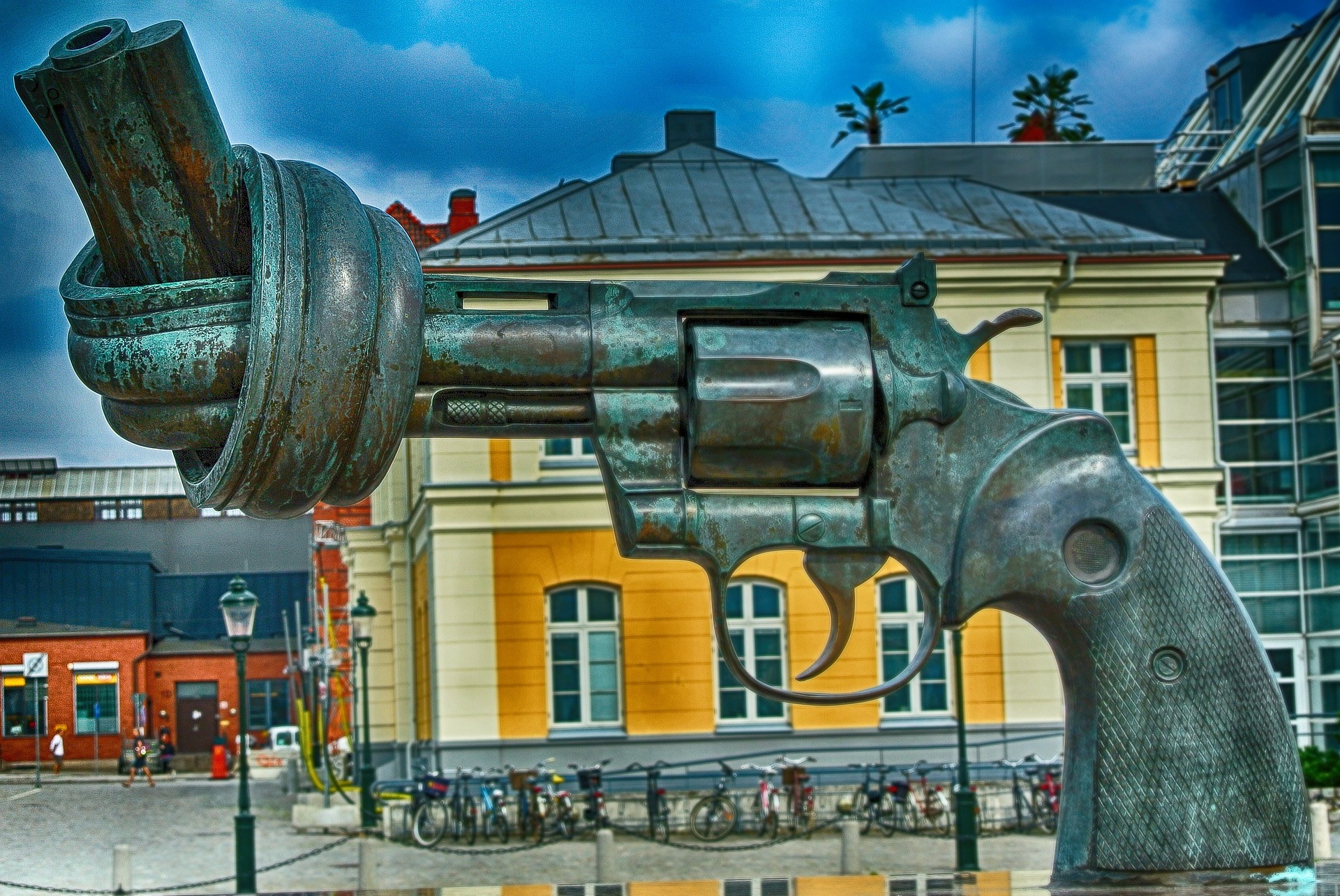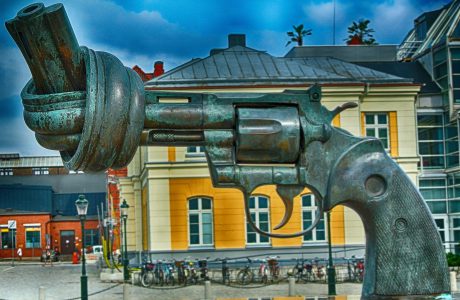 Philo café Victor Schoelcher Logo source: 🔗 https://www.alderan-philo.org/cafe-philo-de-toulouse/ | ||
| Theme | Non-violence, how far? | |
| Animation | ALDERAN association | |
| Place | The brasserie Le Déli’s in Toulouse | |
| Date and times | Tuesday, April 23, 2013 from 8:30 p.m. to 10:30 p.m. | |
| Keywords | apology, café, communication, construction, debate, emotion, limits, origin, philosophy, violence | |
| Information | ||
1. My personal interest▲
For some time now, I have enjoyed going out and participating in philosophical cafés in Toulouse to make my personal contribution as a citizen of the world. I have already made several coffees and this evening remains unforgettable for me for the content and the emotions felt. I share them with you now. My main interest is the theme; I wonder about how the theme will be treated, people’s behavior and I set myself a sort of challenge: not to speak throughout the evening, to remain silent and only to listen, which is an action 🙂
To listen is not to be silent, nor to bury oneself.
Sonia Kanclerski, Pause-café chez Sonia, Café philo Non-violence, how far?, April 2013.
For information, for this philosophical debate, the room was full.
2. Some personal notes▲
During the debate, I wrote some notes in a personal notebook, a red Clairefontaine, a sort of logbook on the content of certain cultural outings… And several notes make me shudder…
Introducing the debate:
- The facilitator will approach non-violence as a moral ethic, rather positive, virtuous for the individual and will invite the participants at the café to question this approach, this behavior at the group level in society. Is the virtuous principle still valid?
- The theme of the debate is reminiscent of Gandhi and his fight for the emancipation of India towards the United Kingdom. Is this an acceptable moral reference?
During the debate, I noted some answers from the participants (whose speaking was regulated by the SOPHIA method). I transcribe them in this article as I understood them and as I understand them in this here and now:
- “To nowhere! We disarm all the oppressed!”
- “Violence is in us! We can’t do anything about it because it is biological in nature. It breaks out according to the circumstances.”
- “It’s like tolerance… The limit: to the point of intolerance… which will give rise to violence.”
- “Violence is everywhere, it has no limits. This is why all societies in the world have created laws to regulate it. We can’t avoid it. We are violent so the question should be ‘How far peaceful can we be?’ Should we risk death to avoid violence?”
- “Non-violence can be understood as resistance to violence. But doing nothing is a form of violence. What are the limits to inaction?”
- “When you receive a slap on one cheek, should you turn the other cheek? We have the right to present another face and not take refuge in passivity.”
- “Non-violence is power because it sheds light. To invite awareness. It’s a media power. The May Day demonstrations, civil disobedience in India with Gandhi, the political position of Nelson Mandela.”
- “Non-violence is hard because you have to be strong in spirit and only a minority of people can apply it. The weak-minded will inevitably use violence because it is easier. Non-violence therefore does not exist. Please note that psychological violence is harsher than physical violence over time. It’s a slow death.”
- “Behind all violence lies fear. What about non-violent communication? Does it work? It’s difficult not to fall into violence in our expression: language, behavior. Violence is natural. Non-violence requires effort, attention. The violence is fascinating. You have to see the passion for the news stories that are successful in being read in the newspapers.”
- “Non-violence is an answer, a method to be used until its effectiveness ends.”
- “Emotion is stronger than reason.”
- “The theme of the debate raises the question of a balance of power. Sacrifice is also great violence.”
- “After a while, you have to be violent. Limits are reached when human values are not respected. You have to show firmness when there is disrespect. To achieve the goal of non-violence, there is therefore a long journey of transformation to be made..”
- “Violence begins when we show aggression.”
- “It’s a question of respect for oneself and others.”
- “Violence is super effective. Just take Tibet and Burma as examples. The Tibetans’ attitude of non-violence led to their genocide. And for Burma, military dictatorships make the law and run the country.“
- “You must be able to learn your own violence so as not to reproduce it in another form. It is daily and personal work, not collective work.”
- “It is a generating phenomenon.”
- “Man is 50% violent and 50% loving. An example: the nuclear power plant is not 100% reliable and safe. The man is the same. It cannot be 100% non-violent. This is also why there are armed terrorist organizations like ETA.”
- “Non-violence is a form of violence, but hidden.”
- “Violence should not be seen as something that only happens emotionally. It can be thought out, organized, planned. Do not reduce it only to brutality.”
- “Torture is a form of violence against the individual.”
- “You have sometimes to be wicked.”
- “Violence is biological and universal. It therefore raises the question of the responsibility of the individual and therefore their irresponsibility.”
- “A slap sometimes wakes others up.”
- “Violence is feeling alive, being noticed. It is the expression of domination.”
- “We have the right to self-defense when we are attacked. We therefore have the right to use violence. The limit is non-assistance to people in danger.”
- “The baby is born in a flurry of violence. It is all the work of culture and education that allows us to deconstruct one’s violence.”
- “Violence is the reason of the strongest.”
- “Never fight people. The limit is touch, contact with the person.”
- “The baby is born non-violent, it’s after that it arrives.”
At the end of the debate:
- The facilitator will invite an openness, a questioning about the effectiveness of non-violence.
- Is the responsibility to use this method ethical and moral?
- It raises the question of protection: how to protect oneself effectively? For one person ? For a group?
- The effectiveness and ethics are questionable but we must see the issues. For the political ideals of Nelson Mandela and Gandhi, the method was rather effective. For the Dalai Lama in Tibet, it is rather a failure: no pressure on China. On the importance of public opinion to obtain a result.
- Being able to measure the effectiveness of non-violence over time and on the limit. Assume this limit at the individual level.
3. My emotions▲
- I left the brewery room stunned, shocked by the debate. It is to this date the only philosophy café that has put me in such a state…
- I had the strong unpleasant sensation that as the debate progressed, we were advocating violence… We had therefore gradually transformed the theme of the philosophy café into a new one: ‘violence, from where?’. Just unbearable.
- (In a tone of irony) Everything is going very well in our society… It’s not possible! They trolled. They smoked the carpet. It’s the end of the world !
- Non-violent communication? Great… What about other forms of expression and communication? Be fair and respectful of people isn’t enough?
- I feel like I’m going to take a cold shower when I get home… No. Too late. It’s already done !
- I respected my personal commitment not to speak. I was in the action of listening. My ears received the various interventions well. For the reception in my head, it’s something else. Without comment or with all the comments in the world.
- Should I be reassured, calm, serene after this listening? Wow! I don’t prefer to know what people think who don’t take the time to to settle down… to ask themselves the question… Sighs.
- A short dialog with a female participant of the café:
From memory:
– This debate is not possible?! All grandpas!
(I agree)
– It’s not nice for grandpas. Yes, it was terrible to listen to…
Sonia Kanclerski, Pause-café chez Sonia, Café philo Non-violence, how far?, April 2013.
- I left the brasserie and the city center of Toulouse particularly angry, as if like a Swiss cuckoo (and this is not flattering for the cuckoo), so much so that to return home I decided to take the ring road in reverse (which extends the journey by a good half hour), but it was taking it the right way for me that evening… I assure you. Bitter smile.
4. My personal point of view▲
I briefly present here some personal reflections on the theme of the debate, which are my own.
- Violence is a social construct and depends on education and environment in which a human being grows up and lives one’s life. It must therefore be deconstructed. Not to be destroyed because we must know how it was built. Anyone who forgets their history is condemned to repeat it.
- To be convinced of the non-biological nature of violence, it is enough to consult the crime statistics in different countries. If it were of biological origin, we would note a certain homogeneity, a certain correlation in the figures and this is not the case. It is therefore a (bad) constructed social phenomenon. Here is a Wikipedia article on the issue: Ranking of countries by intentional homicide rate.
- I have in mind an article on a press release from the Icelandic police (which had an impact on me) where they had to shoot down a madman for the first time in their history because of seriously disturbing public order. Here is a link to a Frech article from the newspaper Le Monde: Icelandic police shoot and kill a man for the first time.
- There are countries, social groups in the world where violence and crime are lower because the culture of rape is absent.
- All violent behavior should be prohibited because it is harmful to the health and integrity of people and is a severe obstacle to their development. It is also useless… A personal reflection to illustrate the point: “We do not agree before, we will therefore agree even more after (the act of violence).”. Irony.
With the desire to share,
Sonia Kanclerski














